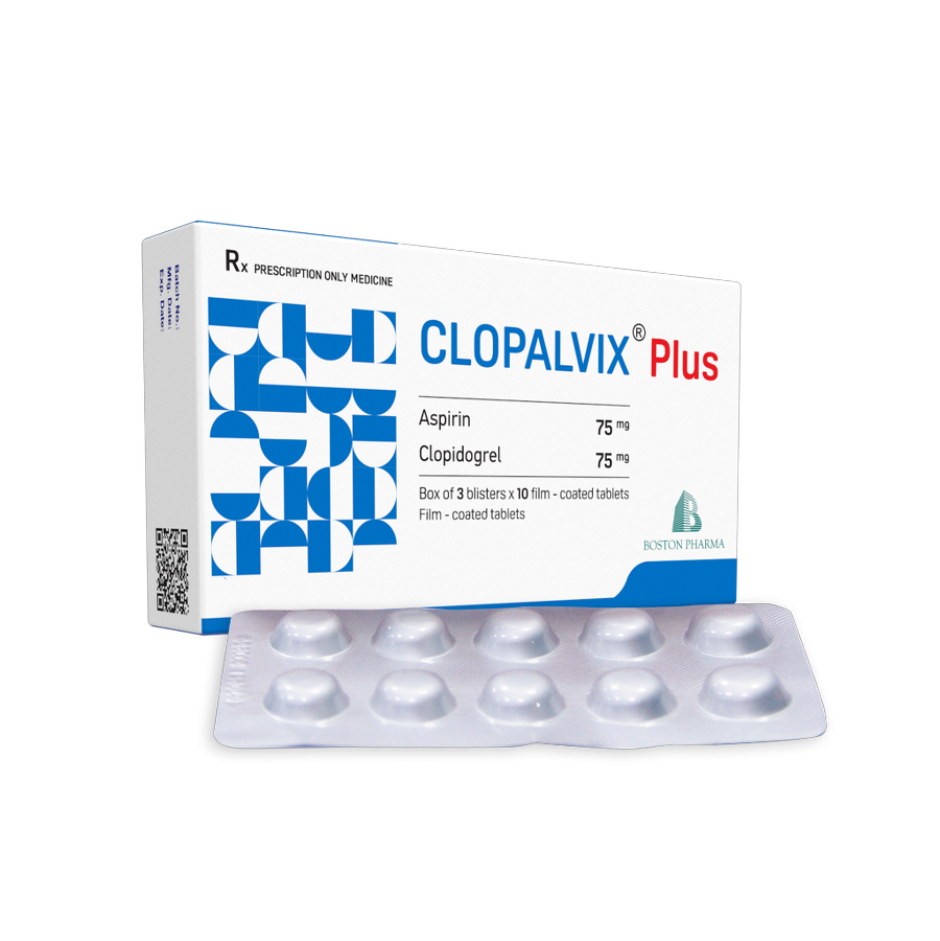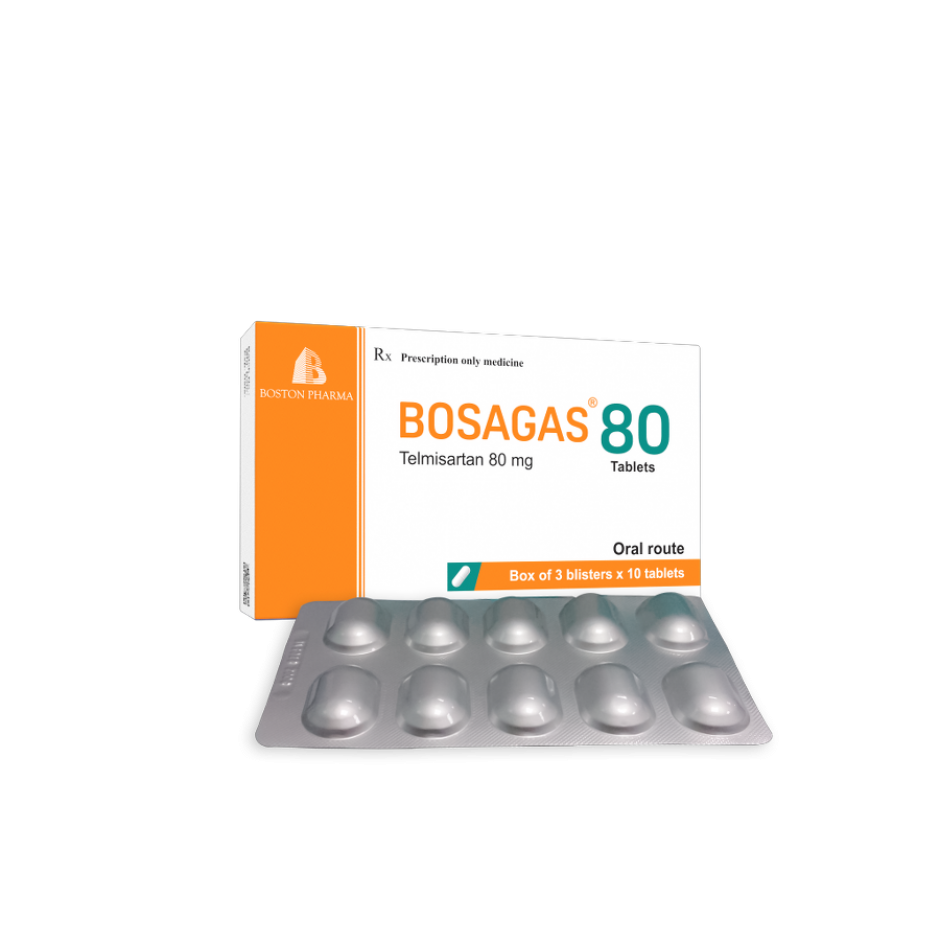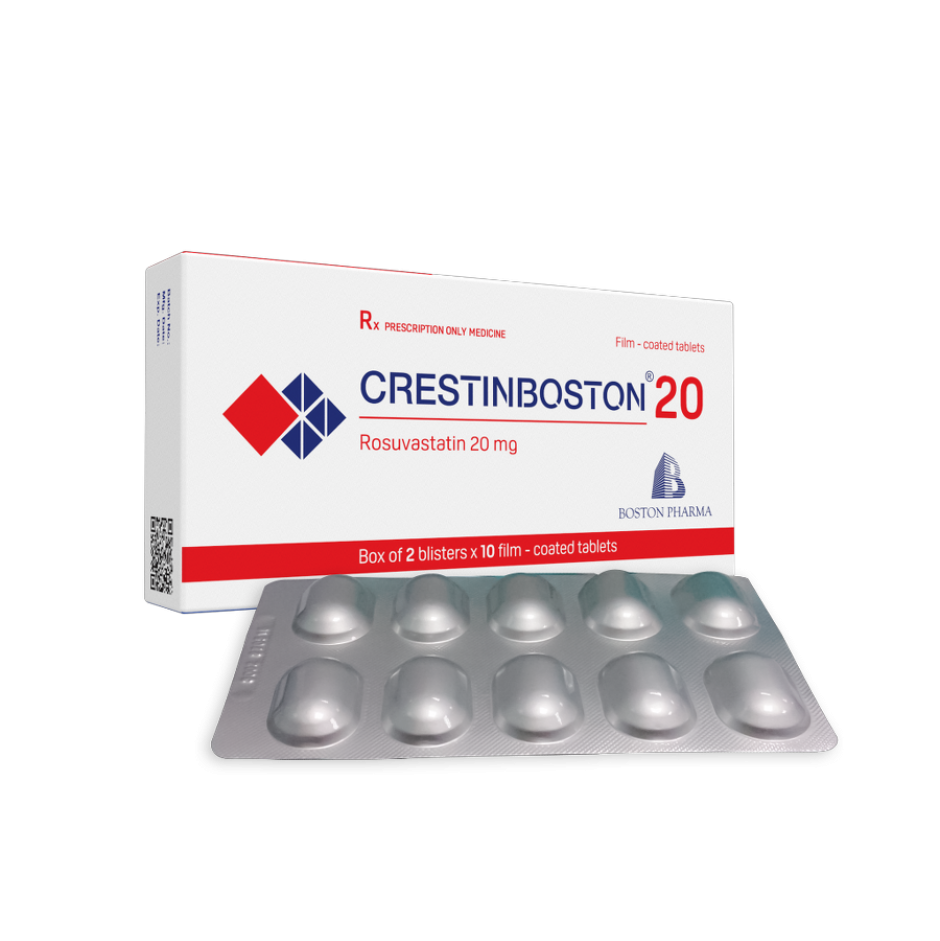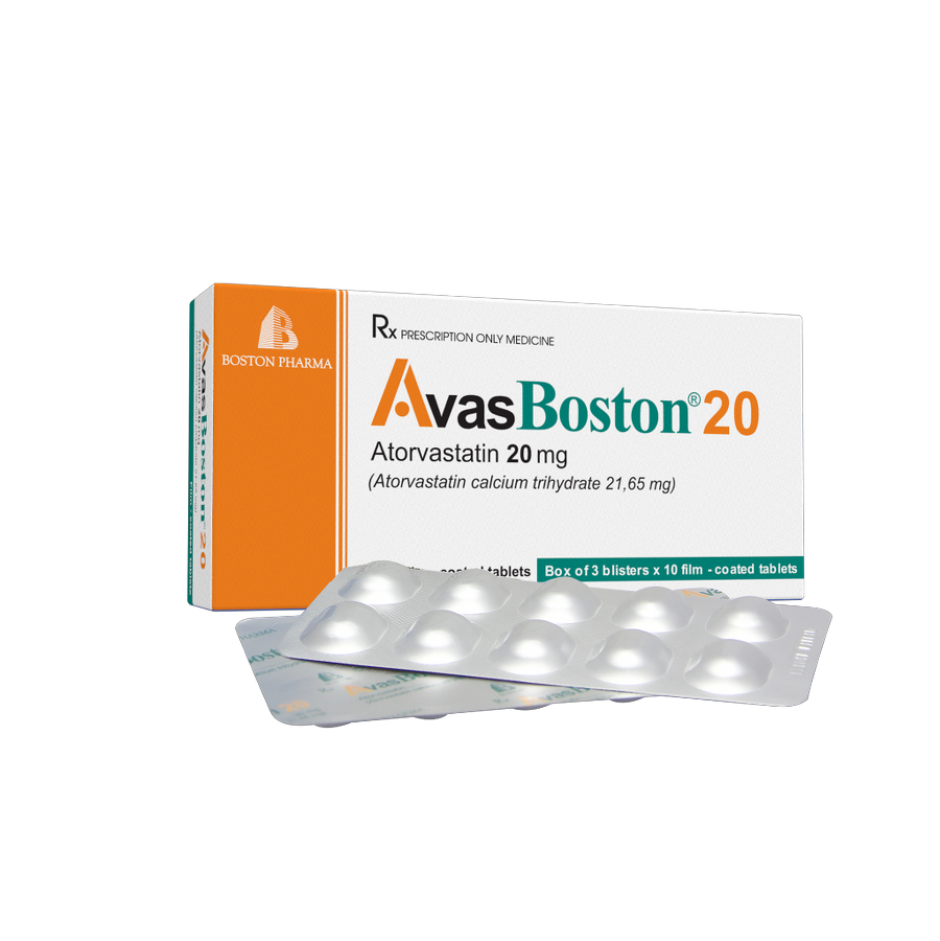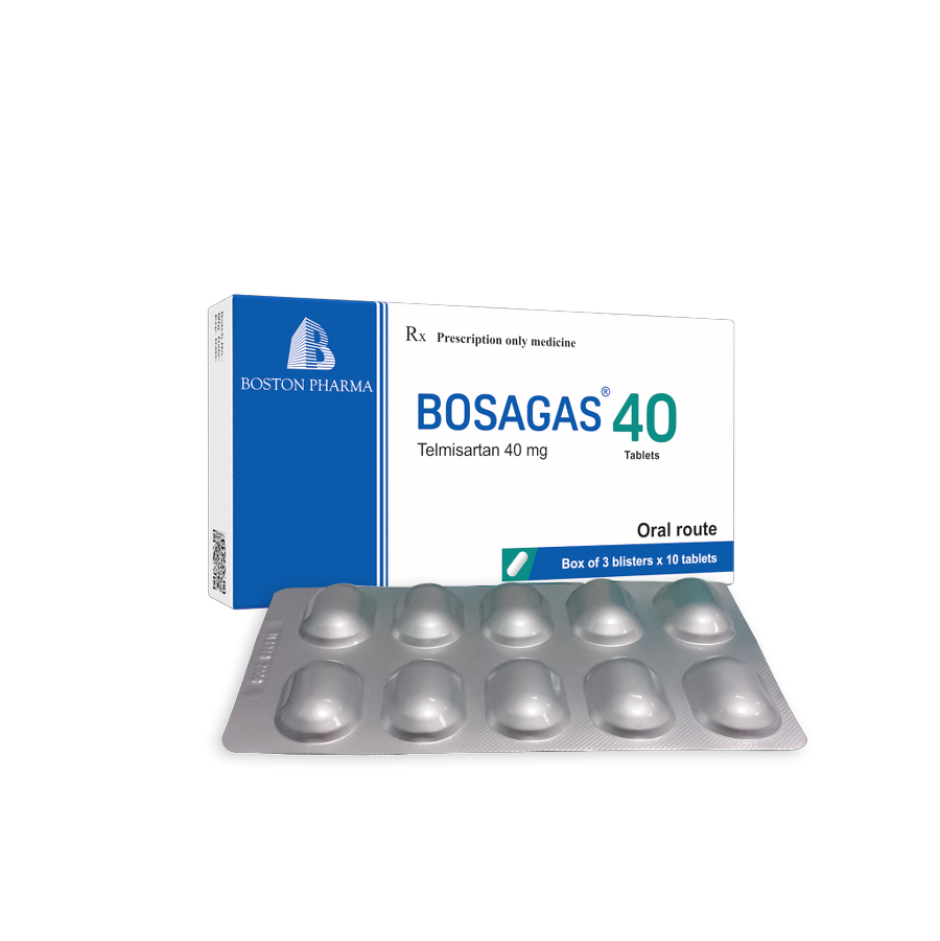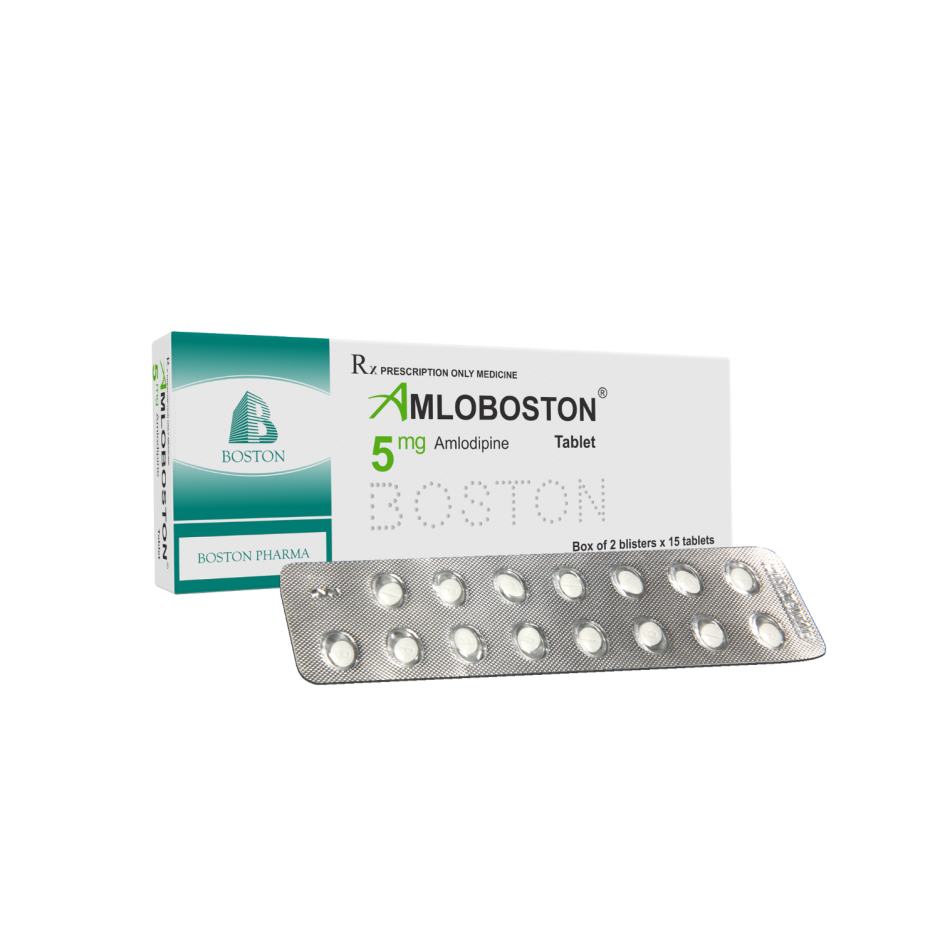DOSAGE AND ADMINISTRATION
Method of administration
Before treatment initiation the patient should be placed on a standard cholesterollowering diet that should continue during treatment. The dose should be individualised according to the goal of therapy and patient response, using current consensus guidelines for the treatment of dyslipidemia to adjust dose of CRESTINBOSTON 10.
CRESTINBOSTON 10 may be given at any time of day, with or without food.
Posology
Treatment of hypercholesterolaemia: The recommended start dose is 5 or 10 mg orally once daily in both statin naive or patients switched from another HMG CoA reductase inhibitor. The choice of start dose should take into account the individual patient's cholesterol level and future cardiovascular risk as well as the potential risk for adverse reactions. A dose adjustment to the next dose level can be made after 4 weeks, if necessary. In light of the increased reporting rate of adverse reactions with the 40 mg dose compared to lower doses, a final titration to the maximum dose of 40 mg should only be considered in patients with severe hypercholesterolemia at high cardiovascular risk (in particular those with familial hypercholesterolemia), who do not achieve their treatment goal on 20 mg, and in whom routine followup will be performed. Specialist supervision is recommended when the 40 mg dose is initiated.
Prevention of cardiovascular events: In the cardiovascular events risk reduction study, the dose used was 20 mg daily.
Pediatric population:
+ In children 10 to 17 years of age with heterozygous familial hypercholesterolemia: The usual dose of CRESTINBOSTON 10 is 5-20 mg orally once daily, the maximum recommended dose is 20 mg once daily (safety and efficacy of doses greater than 20 mg have not been studied in this population). Titration should be conducted according to the individual response and tolerability in pediatric patients, as recommended by the pediatric treatment recommendations. Dose adjustments should only be made after ≥ 4 weeks.
+ Homozygous familial hypercholesterolemia: Experience in children with homozygous familial hypercholesterolemia is limited to a small number of children aged ≥ 8 years.
The elderly: A start dose of 5 mg is recommended in patients >70 years. No other dose adjustment is necessary in relation to age.
Patients with renal impairment: No dose adjustment is necessary in patients with mild to moderate renal impairment. The recommended start dose is 5 mg in patients with moderate renal impairment (creatinine clearance of <60 ml/min). The 40 mg dose is contraindicated in patients with moderate renal impairment. The use of Crestor in patients with severe renal impairment is contraindicated for all doses.
Patients with hepatic impairment: There was no increase in systemic exposure to rosuvastatin in subjects with ChildPugh scores of 7 or below. However, increased systemic exposure has been observed in subjects with ChildPugh scores of 8 and 9. In these patients an assessment of renal function should be considered. There is no experience in subjects with ChildPugh scores above 9. Crestor is contraindicated in patients with active liver disease.
Asian patients: In Asian patients, consider starting with a dose of 5 mg once daily that increases plasma concentrations of rosuvastatin. Note the increased exposure in the Asian population when not sufficiently tested at 20 mg/day.
Concomitant therapy:
+ Use with gemfibrozil: Initiate therapy with 5 mg once daily. The dose of CRESTINBOSTON 10 should not exceed 10 mg once daily.
+ Use with atazanavir or lopinavir and ritonavir or atazanavir and ritonavir: Initiate therapy with 5 mg once daily. The dose of CRESTINBOSTON 10 should not exceed 10 mg once daily.
Rosuvastatin is a substrate of various transporter proteins (e.g. OATP1B1 and BCRP). The risk of myopathy (including rhabdomyolysis) is increased when Crestor is administered concomitantly with certain medicinal products that may increase the plasma concentration of rosuvastatin due to interactions with these transporter proteins (e.g. ciclosporin and certain protease inhibitors including combinations of ritonavir with atazanavir, lopinavir, and/or tipranavir). Whenever possible, alternative medications should be considered, and, if necessary, consider temporarily discontinuing CRESTINBOSTON 10 therapy. In situations where coadministration of these medicinal products with CRESTINBOSTON 10 is unavoidable, the benefit and the risk of concurrent treatment and Crestor dosing adjustments should be carefully considered
CONTRAINDICATIONS
In patients with hypersensitivity to rosuvastatin or to any of the excipients.
In patients with active liver disease including unexplained, persistent elevations of serum transaminases and any serum transaminase elevation exceeding 3 x the upper limit of normal (ULN).
In patients with severe renal impairment (creatinine clearance <30 ml/min).
In patients with myopathy.
In patients receiving concomitant ciclosporin.
During pregnancy and lactation and in women of childbearing potential not using appropriate contraceptive measures.
The 40 mg dose is contraindicated in patients with predisposing factors for myopathy/rhabdomyolysis. Such factors include:
Moderate renal impairment (creatinine clearance < 60 ml/min).
Hypothyroidism.
Personal or family history of hereditary muscular disorders.
Previous history of muscular toxicity with another HMGCoA reductase inhibitor or fibrate.
Alcohol abuse.
Situations where an increase in plasma levels may occur.
Asian patients.
Concomitant use of fibrates.
WARNINGS AND PRECAUTIONS
Renal Effects: Proteinuria, detected by dipstick testing and mostly tubular in origin, has been observed in patients treated with higher doses of Crestor, in particular 40 mg, where it was transient or intermittent in most cases. Proteinuria has not been shown to be predictive of acute or progressive renal disease. An assessment of renal function should be considered during routine followup of patients treated with a dose of 40 mg.
Liver Effects: As with other HMGCoA reductase inhibitors, CRESTINBOSTON 10 should be used with caution in patients who consume excessive quantities of alcohol and/or have a history of liver disease.
It is recommended that liver function tests be carried out prior to, and 3 months following, the initiation of treatment. CRESTINBOSTON 10 should be discontinued or the dose reduced if the level of serum transaminases is greater than 3 times the upper limit of normal.
In patients with secondary hypercholesterolaemia caused by hypothyroidism or nephrotic syndrome, the underlying disease should be treated prior to initiating therapy with CRESTINBOSTON 10.
Skeletal Muscle Effects:
Effects on skeletal muscle e.g. myalgia, myopathy and, rarely, rhabdomyolysis have been reported in Crestortreated patients with all doses and in particular with doses > 20 mg. Very rare cases of rhabdomyolysis have been reported with the use of ezetimibe in combination with HMGCoA reductase inhibitors. A pharmacodynamic interaction cannot be excluded and caution should be exercised with their combined use. As with other HMGCoA reductase inhibitors, the reporting rate for rhabdomyolysis associated with Crestor in postmarketing use is higher at the 40 mg dose.
Creatine Kinase Measurement
Creatine Kinase (CK) should not be measured following strenuous exercise or in the presence of a plausible alternative cause of CK increase which may confound interpretation of the result. If CK levels are significantly elevated at baseline (>5xULN) a confirmatory test should be carried out within 5 – 7 days. If the repeat test confirms a baseline CK >5xULN, treatment should not be started.
Consider creatine kinase (CK) monitoring in case:
Before Treatment
CRESTINBOSTON 10, as with other HMGCoA reductase inhibitors, should be prescribed with caution in patients with predisposing factors for myopathy/rhabdomyolysis. Such factors include:
+ Renal impairment
+ Hypothyroidism
+ Personal or family history of hereditary muscular disorders
+ Previous history of muscular toxicity with another HMGCoA reductase inhibitor or fibrate
+ Alcohol abuse
+ Age >70 years
+ Situations where an increase in plasma levels may occur
+ Concomitant use of fibrates.
+ In such patients the risk of treatment should be considered in relation to possible benefit and clinical monitoring is recommended. If CK levels are significantly elevated at baseline (>5xULN) treatment should not be started.
Whilst on Treatment
Patients should be asked to report inexplicable muscle pain, weakness or cramps immediately, particularly if associated with malaise or fever. CK levels should be measured in these patients. Therapy should be discontinued if CK levels are markedly elevated (>5xULN) or if muscular symptoms are severe and cause daily discomfort (even if CK levels are ≤ 5x ULN). If symptoms resolve and CK levels return to normal, then consideration should be given to reintroducing rosuvastatin or an alternative HMGCoA reductase inhibitor at the lowest dose with close monitoring. Routine monitoring of CK levels in asymptomatic patients is not warranted. There have been very rare reports of an immunemediated necrotising myopathy (IMNM) during or after treatment with statins, including rosuvastatin. IMNM is clinically characterised by proximal muscle weakness and elevated serum creatine kinase, which persist despite discontinuation of statin treatment.
In clinical trials there was no evidence of increased skeletal muscle effects in the small number of patients dosed with rosuvastatin and concomitant therapy. However, an increase in the incidence of myositis and myopathy has been seen in patients receiving other HMGCoA reductase inhibitors together with fibric acid derivatives including gemfibrozil, ciclosporin, nicotinic acid, azole antifungals, protease inhibitors and macrolide antibiotics. Gemfibrozil increases the risk of myopathy when given concomitantly with some HMGCoA reductase inhibitors. Therefore, the combination of rosuvastatin and gemfibrozil is not recommended. The benefit of further alterations in lipid levels by the combined use of rosuvastatin with fibrates or niacin should be carefully weighed against the potential risks of such combinations. The 40 mg dose is contraindicated with concomitant use of a fibrate.
Combination with rosuvastatin and systemic forms of fusidic acid or within 7 days of discontinuation of fusidic acid therapy are contraindicated. In patients requiring systemic fusidic acid, statin therapy should be discontinued for the duration of fusidic acid therapy. There have been reports of rhabdomyolysis (including some fatalities) in patients receiving this combination. Patients should be advised about seeking immediate medical assistance if they experience any symptoms of muscle weakness, muscle pain or tenderness. It is possible to resume statin therapy 7 days after the last dose of fusidic acid. In special cases where prolonged systemic use of fusidic acid is required, e.g. for the treatment of severe infections, the concomitant use of rosuvastatin and fusidic acid should be considered on a case-by-case basis and under close medical supervision.
Rosuvastatin therapy should also be temporarily withheld in any patient with an acute, serious condition suggestive of myopathy or predisposing to the development of renal failure secondary to
rhabdomyolysis (e.g., sepsis, hypotension, dehydration, major surgery, trauma, severe metabolic, endocrine, and electrolyte disorders, or uncontrolled seizures)
Endocrine Effects: Increases in HbA1c and fasting serum glucose levels have been reported with HMG-CoA reductase inhibitors, including CRESTINBOSTON 10. Based on clinical trial data with rosuvastatin, in some instances these increases may exceed the threshold for the diagnosis of diabetes mellitus. Although clinical studies have shown that rosuvastatin alone does not reduce basal plasma cortisol concentration or impair adrenal reserve, caution should be exercised if rosuvastatin is administered concomitantly with drugs that may decrease the levels or activity of endogenous steroid hormones such as ketoconazole, spironolactone, and cimetidine.
Race: Pharmacokinetic studies show an increase in exposure in Asian subjects compared with Caucasians.
Protease inhibitors: Increased systemic exposure to rosuvastatin has been observed in subjects receiving rosuvastatin concomitantly with various protease inhibitors in combination with ritonavir. Consideration should be given both to the benefit of lipid lowering by use of Crestor in HIV patients receiving protease inhibitors and the potential for increased rosuvastatin plasma concentrations when initiating and up titrating Crestor doses in patients treated with protease inhibitors. The concomitant use with certain protease inhibitors is not recommended unless the dose of Crestor is adjusted.
Concomitant use of statins with lipid-lowering agents for HIV and hepatitis C virus (HCV) protease inhibitors may increase the risk of muscle damage, most seriously rhabdomyolysis. Kidney damage is the result of rhabdomyolysis, which can lead to kidney failure and death. Co-administration with protease inhibitors is not recommended (see Interactions).
Interstitial lung disease: Exceptional cases of interstitial lung disease have been reported with some statins, especially with long term therapy. Presenting features can include dyspnoea, nonproductive cough and deterioration in general health (fatigue, weight loss and fever). If it is suspected a patient has developed interstitial lung disease, statin therapy should be discontinued.
Diabetes Mellitus: Some evidence suggests that statins as a class raise blood glucose and in some patients, at high risk of future diabetes, may produce a level of hyperglycaemia where formal diabetes care is appropriate. This risk, however, is outweighed by the reduction in vascular risk with statins and therefore should not be a reason for stopping statin treatment. Patients at risk (fasting glucose 5.6 to 6.9 mmol/l, BMI >30 kg/m2, raised triglycerides, hypertension) should be monitored both clinically and biochemically according to national guidelines.
Paediatric population: A study treatment in 2 years shows no effect on growth, weight, BMI or sexual maturation was detected in paediatric patients 6 to 17 years of age.
Excipients ingredients: Careful use is required because the drug contains sunset yellow, ponceau 4R, which can cause allergic applications
SHELF-LIFE
36 months from the manufacturing date.



_AF_CRESTINBOSTON_900x900.png)
